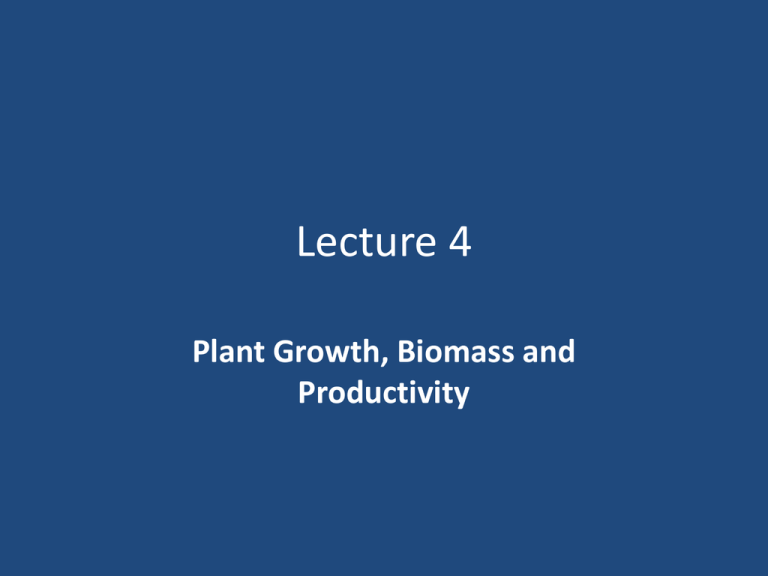Plant Growth, Biomass and Productivity
advertisement

Lecture 4 Plant Growth, Biomass and Productivity Lecture 4 topics 1. How plants grow 2. Carbon allocation 3. Forest Biomass and Forest Productivity Week 2 Learning Objectives You should be able to: • Recognize characteristics and general distribution of biomes and what factors influence their spatial coverage • Describe difference between biome based on actual cover and potentialcover (spatially and temporally) • Describe various biome/life zone types (globally and locally) and their productivity • Understand spatial variation (gradients) in forest types (e.g., elevation, latitude, disturbance, temperature, precipitation) • Describe basic photosynthesis and plant productivity (gross primary productivity, net primary productivity, differences in plant requirements) • Understand the role of vegetation in carbon storage (sequestration) • Think about spatial and temporal differences in ecosystems 1. How plants grow . a. MERISTEMS In humans and other animals growth can occur in most parts of the body. Trees do not grow like this and only produce new cells in a very limited number of places called meristems (zones of intense activity). Trees grow in height as a result of apical meristems that are located at their branch tips. All buds that you see on a tree contain apical meristems Roots also expand through the soil as a result of root-tip apical meristems. Trunk diameter growth occurs as a result of another meristem called vascular cambium. Apical meristems (primary); cambium (secondary) • Unlike animals, plants continue to grow throughout their life span (can’t move) • They have meristems which correspond to stem cells in animals (can differentiate into any organ) • Apical meristems on roots and shoots • Respond to light, searching for soil resources, responding to herbivory Buds Roots Primary meristems Secondary meristems cause it to grow laterally (i.e., larger in diameter). Vascular cambium, produces secondary xylem and secondary phloem Where plants grow and what they need • Species have different needs for many abiotic factors including: – Light – Water (precipitation) – Nutrients – Soil types – Temperature Ages and dimensions of forest trees on better sites in the PNW and shade tolerance Species (conifers) Age (yrs) Diam (cm) Ht (m) Tol Thuja plicata (western red cedar) Chamaecyparis nootkatensis (Alaska yellow cedar) Picea sitchensis (Sitka spruce) Pseudotsuga menziesii Doug fir) Larix occidentalis (W. larch) Pinus ponderosa (ponderosa pine) Picea engelmannii (Engelmann spruce) Abies amabilis (Pacific silver fir) Abies procera (Noble fir) Pinus monticola W. white pine) Tsuga heterophylla (W. hemlock) Tsuga mertensiana (Mt. hemlock) Abies grandis (grand fir) Abies lasiocarpa (subalpine fir) Pinus contorta (lodgepole pine) 1000+ 1000+ 150-300 100-150 60+ 30-40 TOL TOL 800+ 750+ 700+ 600+ 500 180-230 150-220 140 75-125 100+ 70-75 70-80 50 30-50 45-50 TOL INTOL INTOL INTOL TOL 400+ 400+ 400+ 400+ 400+ 300+ 250+ 250+ 90-100 100-150 110 90-120 75-100 75-125 50-60 50 45-50 45-70 60 50-65 25-35 40-60 25-35 25-35 VTOL INTOL INTER VTOL TOL TOL TOL INTOL Hardwoods Species Age Diam (yrs) (cm) Ht (m) Tol Quercus garryana (Garry oak) 500 60-90 15-25 INTOL Acer macropyhyllum (Big leaf maple) 300+ 50 15 TOL Populus trichocarpa (Cottonwood) 200+ 75-90 25-35 INTOL Alnus rubra (red alder) 100 55-75 30-40 INTOL 2. Carbon allocation So where does the Carbon come from? Carbon dioxide via photosynthesis PRODUCTIVITY Photosynthesis CO2 + H2O + light C6H12O6 + O2 + H20 Respiration: C6H12O6 + O2 CO2 + H2O + energy Production – increase in biomass or volume on a given area over a given time period (usually a year). Gross Primary Production (GPP) = Photosynthesis Net Primary Production (NPP) = Photosynthesis – Respiration homestead-farm.net Measures of Productivity • Ecological production and production for energy – biomass production - (kg per ha per year or g C /sq m/year or Kcal/sq m/year)* • Timber production (board feet per acre per year, cubic feet per acre per year or cubic meters per hectare per year) • Energy – kcal per square meter per year • Tree height at a given age for given species. e.g., Douglas-fir * 1 g Carbon ~ 2.2 g organic matter ~ 8420 Kcal microbewiki.kenyon.edu How do plants partition biomass (carbon, carbohydrates)? Goal is to minimize resource limitation and maximize resource capture and NPP If water or nutrients are limiting: grow roots utsa.edu If light is limiting: grow shoots article.wn.com 3. Biomass and Productivity Biomass • Biomass (the quantity of living plant material) is most abundant in forests. • Tropical forests account for 50% of Earth’s total plant biomass, although they occur on only 13% of the ice-free land area; • Other forests contribute an additional 30% of global biomass (Chapin et al. 2002) • Measured in various ways: – – – – – in-situ measurements, national forest inventories, administrative-level statistics, model outputs and regional satellite products. Hoh Rainforest Biomass (Old-growth forest – Hoh River Valley,WA) – Mg/ha (western hemlock, Douglas-fir, western redcedar, Pacific silver fir, Sitka spruce) Total live tree Shrubs and herbs Standing dead trees Logs Dead shrubs and herbs Forest floor Soil Roots TOTAL 1044.1 0.7 171.0 92.3 0.5 89.8 360.3 -----1758.6 Terrestrial Production • Carbon balance of vegetation governs productivity of the biosphere • Enters the system as gross primary productivity (GPP) and accumulates as biomass • Returns to atmosphere via respiration or disturbance • NPP (Net primary production) = GPP – respiration • Plants lose carbon through other avenues besides respiration, e.g., • Litterfall • Root exudations (secretions of soluble organic compounds) • Carbon transfers to microbes • To herbivores (being eaten) Net Primary Production (NPP) – kg (g C, Kcal) per hectare per year NPP = Growth + Detritus (Litterfall, etc.) + Loss to Grazing Average Net Primary Productivty (kcal/m2/year Estuaries Swamps/Marshes Tropical rain forest Temperate forest Northern conifer Savanna Ag land Woodland/shrubland Temperate grassland Lakes and streams Continental shelf Tundra Open ocean Desert scrub Extreme desert Open ocean ropical rain forest emperate forest avanna Northern conifer ontinental shelf Ag land emperate grassland Woodland/shrubland stuaries wamps and marshes Desert scrub akes and streams undra xtreme desert Total global net productivity (billion kcal/year Site Index • Site index : measure of the productivity of a site based on how tall trees will grow over a specified period of time. • Indexes to a base age, usually 50 or 100. • For example, a 50-year site index of 120 means that at age 50, the dominant trees (of the given species) would be expected to be 120 feet tall. T • Higher the site index, signifies more productive a sites for a given species • Can get site class information from USDA http://websoilsurvey.nrcs.usda.gov/app/HomePage.htm. Total height (ft) Age at Breast Height - Years theglobaleducationproject.org Carbon sequestration • the process through which carbon dioxide (CO2) from the atmosphere is absorbed by trees, plants and crops through photosynthesis, and stored as carbon in biomass (tree trunks, branches, foliage and roots) and soils. • Forests and soils have a large influence on atmospheric levels of carbon dioxide (CO2) • Tropical deforestation is responsible for about 20% of the world's annual CO2 emissions, these emissions are more than offset by the uptake of atmospheric CO2 by forests and agriculture. Carbon sequestration • Carbon sequestration rates vary by tree species, soil type, regional climate, topography and management practice. • Carbon accumulation in forests and soils eventually reaches a saturation point • Economic considerations and end use of wood product is important Methods of sequestration in land management • Management Afforestation Tonnes C/acre/year Time to saturation (yrs) 0.6- 2.6 90- 120 Reforestation 0.3- 2.1 90-120 Lengthening rotations 0.2-0.8 15-20 Switch to reduced tillage 0.2-0.3 15-50 Grazing changes 0.02- 0.5 25-50 Tonnes of carbon (C) per hectare (total carbon Gt) 162 35 85 Central Am 175 75 105 How Can Forest Management Help with Carbon Storage? Best case scenario: On a global basis, forests could store up to one-third of total carbon emissions. Longer rotations; bigger effect on westside than eastside Retain woody debris on site or utilize it for products Extend the life cycle of wood products; encourage recycling, re-use Protect forests from crown fire (suppression, fuel management) Summary • Photosynthesis drives the carbon cycle • Plants allocate carbon to maximize resource use • Productivity is affected by a suite of ecological conditions • Management can play a role in carbon sequestration








